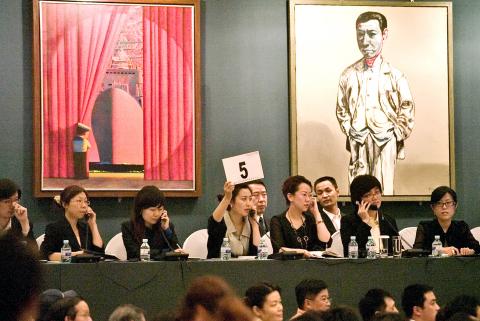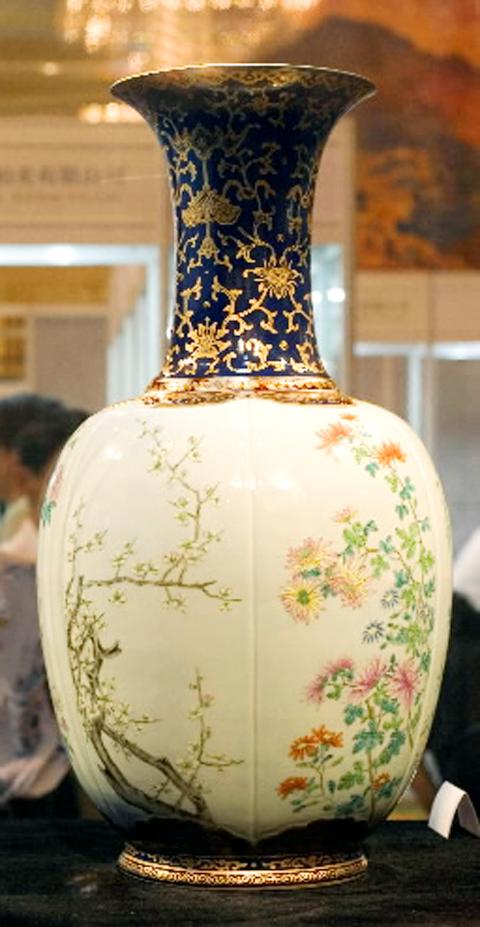Until recently, few in the art world had even heard of China’s auction houses. Today, they are among the world’s biggest by revenue, posing a serious challenge to the likes of Sotheby’s and Christie’s.
Though still much smaller in size than their foreign rivals, China’s
auction houses now account for five of the world’s top 10 by revenue, according to a recent report by the France-based industry association Conseil des Ventes.

Photo: Bloomberg
Their rise has been fuelled by wealthy Chinese collectors’ vast appetite for art and antiques and aided by regulations that have locked overseas competitors out of China.
It nevertheless represents an extraordinary turnaround for an industry that has for centuries been dominated by a handful of established European brands.
“From 1776, when we were founded, to about five years ago, our main competitor was Sotheby’s. Well, today in Asia, the landscape has changed,” explains Francois Curiel, president of Christie’s Asia. “For the first time in history, local auction houses are doing better than us in a local market.”

Photo: Bloomberg
The two biggest, Beijing Poly and China Guardian, rank only just behind Christie’s and Sotheby’s, having overtaken more established names such as Bonham’s in just a few years.
Last year Poly booked sales of US$190 billion — more than the combined revenues of Christie’s and Sotheby’s for the entire Asia region. China Guardian recorded revenues of US$1.8 billion, up from US$282 million only three years ago.
Their success comes as China’s new breed of art collectors have propelled Beijing, and to a lesser extent Shanghai, to the forefront of the art scene, with Chinese works of art regularly breaking records at auction.
Last year Qi Bashi (齊白石) and Chang Ta-chien (張大千), two modern Chinese artists who specialize in ink paintings and calligraphy, overtook Pablo Picasso and Andy Warhol as the world’s best-selling artists by auction revenue.
A Qi painting titled Eagle Standing on Pine Tree sold for US$57.2 million in May last year, the highest price reached by any work of art at auction last year.
“China’s new rich have very little way of spending their money. Art is one of them,” said Wang Yannan (王雁南), director and president of China Guardian, which was founded in 1993.
Beijing is now the world’s biggest art market, with 27 percent of global auction revenues, according to data compiled by the specialist Web site Art Price.
But foreign auction houses are not allowed to set up shop in China, putting them at a geographical disadvantage in targeting Chinese buyers, although both Christie’s and Sotheby’s have booming operations in Hong Kong.
“Five years ago, China business was four percent of our annual sales in Hong Kong. Now that figure has risen to between 40 and 50 percent,” said Kevin Ching, chief executive of Sotheby’s Asia. “A lot of this can be attributed to the rise of China as a world economic and political power.”
While Christie’s and Sotheby’s have to limit their presence in Beijing to a sales bureau and previews, several Chinese auction houses are expanding overseas.
Poly and Guardian have both opened offices abroad to source Chinese art, much of which is in Western collections.
They are courting sellers in Europe and the US by offering them greater access to Chinese buyers than the foreign auction houses operating out of Hong Kong. “We are facing a lot of competition outside of China. Poly and Guardian have opened offices overseas to source as much as artwork as possible, and they picked up very quickly,” said Curiel of Christie’s Asia. “Generally, Chinese buyers are looking for the best.”
Both Chinese houses are also looking to gain a foothold in Hong Kong, attracted by the territory’s tax-free status — import tax on works of art reaches up to 25 percent in China — and its reputation for probity.
Chinese auction houses operate in a much less strictly regulated environment than their Western counterparts, and there are widespread reports of fake works of art being sold and of bills going unpaid by buyers.
And as Chinese buyers’ tastes diversify, Poly and Guardian expect to cast their nets wider to Western art — putting them even more directly in competition with the likes of Sotheby’s and Christie’s.
“We have had interest from Western buyers,” said Guardian’s Wang. “It’s something we are looking at closely and would consider in the long term.”

Following the shock complete failure of all the recall votes against Chinese Nationalist Party (KMT) lawmakers on July 26, pan-blue supporters and the Chinese Communist Party (CCP) were giddy with victory. A notable exception was KMT Chairman Eric Chu (朱立倫), who knew better. At a press conference on July 29, he bowed deeply in gratitude to the voters and said the recalls were “not about which party won or lost, but were a great victory for the Taiwanese voters.” The entire recall process was a disaster for both the KMT and the Democratic Progressive Party (DPP). The only bright spot for

As last month dawned, the Democratic Progressive Party (DPP) was in a good position. The recall campaigns had strong momentum, polling showed many Chinese Nationalist Party (KMT) lawmakers at risk of recall and even the KMT was bracing for losing seats while facing a tsunami of voter fraud investigations. Polling pointed to some of the recalls being a lock for victory. Though in most districts the majority was against recalling their lawmaker, among voters “definitely” planning to vote, there were double-digit margins in favor of recall in at least five districts, with three districts near or above 20 percent in

From Godzilla’s fiery atomic breath to post-apocalyptic anime and harrowing depictions of radiation sickness, the influence of the nuclear bombings of Hiroshima and Nagasaki runs deep in Japanese popular culture. In the 80 years since the World War II attacks, stories of destruction and mutation have been fused with fears around natural disasters and, more recently, the Fukushima crisis. Classic manga and anime series Astro Boy is called “Mighty Atom” in Japanese, while city-leveling explosions loom large in other titles such as Akira, Neon Genesis Evangelion and Attack on Titan. “Living through tremendous pain” and overcoming trauma is a recurrent theme in Japan’s

The great number of islands that make up the Penghu archipelago make it a fascinating place to come back and explore again and again. On your next trip to Penghu, why not get off the beaten path and explore a lesser-traveled outlying island? Jibei Island (吉貝嶼) in Baisha Township (白沙鄉) is a popular destination for its long white sand beach and water activities. However, three other permanently inhabited islands in the township put a unique spin on the traditional Penghu charm, making them great destinations for the curious tourist: Yuanbeiyu (員貝嶼), Niaoyu (鳥嶼) and Dacangyu (大倉嶼). YUANBEIYU Citou Wharf (岐頭碼頭) connects the mainland